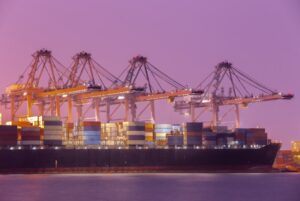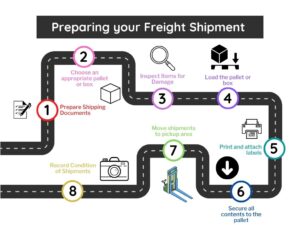23/11/2023
Freight shipping serves as a method for businesses to move bulk shipments that go beyond the weight and size limitations of parcel packages. Typically, this type of cargo is packaged and transported on pallets.
What is Freight?r
The term “freight” can be used to refer to any cargo requiring transportation from one location to another, ineligible for parcel shipping commonly used in smaller packages. Criteria defining freight can vary by carrier, often including items weighing over 150 pounds, measuring more than 108 inches in length, or exceeding 160 inches in length plus girth (twice the sum of width and height). Goods transported on pallets are generally classified as freight.
Freight can include a wide range of items, including large quantities of smaller goods consolidated on pallets. Examples of products often requiring freight delivery are furniture, automobiles, construction materials, and specific outdoor activity equipment. Common freight carriers exclude hazardous items like aerosols and fireworks, valuable products like jewels, and perishables such as meats and frozen foods, though there are specialized carriers available for these shipments.
What is Freight Shipping?
Freight shipping refers to the various transportation methods tailored for the movement of larger shipments across different locations, playing a pivotal role in global logistics networks. These methods may involve a combination of ships, planes, trains, and trucks. Consider a U.S.-based contributor sourcing most of its goods from Asia; these goods are loaded into a shipping container, traversing the Pacific to a West Coast port. Subsequently, a truck or train transports them to their final destination, often arriving months after departure from an Asian port.
In contrast to parcel shipments using delivery trucks like FedEx, UPS, or Amazon, familiar to us all, freight shipments involve sizable, heavy loads necessitating semi-trucks and other high-capacity transportation modes.
Measurement of freight shipments typically revolves around the space they would occupy in a semi-truck trailer, categorized as full truckload or less than truckload (LTL).

Although it’s uncommon for customer orders to be delivered via freight, it serves as the primary method for companies to receive and, in some cases, send goods, influencing both inbound and outbound logistics. Product-oriented businesses, requiring substantial quantities of parts, materials, and finished products, often opt for bulk orders. Even service organizations necessitate supplies for their offices and staff, often procured in large quantities.
Freight shipping proves to be more cost-effective and efficient compared to dividing such cargo into smaller shipments handled by parcel services. The processes and equipment involved in moving large, heavy goods differ significantly from those for relatively small packages delivered swiftly to your doorstep by a delivery van. While companies like UPS and FedEx offer both parcel and freight services, these operate as distinct entities.
Businesses should be aware of their options and the regulations of various carriers rather than defaulting to freight shipping with a familiar carrier. There might be viable alternatives, such as breaking down a smaller freight shipment into multiple smaller parcel shipments.
Freight Shipping Modes
There are many different kinds of freight shipping tailored to meet different business needs. Factors such as volume, type, and urgency of goods influence the choice of the most suitable mode. Shipping providers should offer quotes for different options, allowing businesses to select the option that aligns best with their needs.
Less Than Truckload (LTL):
For smaller freight shipments, LTL is a cost-effective choice, sharing trailer space with other businesses. Despite being slower due to additional stops and loading/unloading, it is suitable for shipments ranging from 150 to 15,000 pounds.
Full Truckload:
Larger bulk shipments exceeding 15,000 pounds require a full truckload, offering faster transit without extra stops or detours, reducing the risk of damage.
Partial Truckload:
Similar to LTL, partial truckload involves sharing space with other shippers, but shipment sizes are typically larger (over 5,000 pounds).
Sea Transport:
Shipping via ships is a globally popular method due to its cost-effectiveness and ability to cover long routes across continents. Approximately 80% of global goods shipped travel by sea at some point.
Air Freight:
Planes provide the fastest but most expensive option for swift delivery, often reserved for rush orders or small, high-priority shipments.
Rail Freight:
Trains offer a cost-effective means to move freight cargo, especially for non-time-sensitive shipments. Trains may transport goods to or from ports, connecting them to the final destination for last-mile delivery.
Intermodal:
Combining multiple freight transportation methods, intermodal shipments can involve ground, air, and sea transport. While often cost-effective, it may take longer due to multiple modes.
Expedited:
Ideal for tight timelines, expedited freight shipping ensures swift delivery using planes and trucks, albeit at a premium cost.

Benefits of Freight Shipping
Freight shipping stands out as one of the most prevalent global shipment methods for various reasons, particularly for the movement of large orders. Several key advantages highlight why freight shipping is widely favored:
Cost-Effective:
Freight shipping proves to be an economical choice for transporting large quantities of goods, especially when utilizing ships or trains. This is particularly noteworthy with Less Than Truckload (LTL), significantly reducing truck transportation costs, a crucial consideration amid escalating shipping expenses.
Versatility in Load and Quantity:
Freight shipping can accommodate diverse loads, including numerous pallets and the heaviest, most unconventional packages. Few other methods rival the broad range of goods that freight can handle.
Environmental Friendliness:
Consolidating shipments for multiple companies on ships, rail cars, and trucks optimizes each trip, curbing additional emissions-generating journeys. This aligns with the growing consumer focus on the environmental impact of the companies they support.
Diverse Options:
Freight shipping not only accommodates various types of goods but also provides businesses with a range of choices concerning speed, costs, and shipment sizes. This extensive selection empowers shippers to choose the most suitable option for any given transport.
Reliability:
Despite recent disruptions in supply chains affecting all shipping methods, freight remains a generally reliable means to move products, ensuring shipments reach their destinations by the promised date. This enhances on-time delivery and other key performance indicators (KPIs), with even LTL shipments often adhering to regular schedules as carriers group regular customers from the same area and follow consistent timelines.
Factors That Define Freight Shipping Rates
If a company is uncertain about whether to opt for freight or parcel shipping, they can utilize online estimator tools provided by various carriers to estimate the cost. Generally, the primary factor influencing the overall price is the total shipping capacity consumed by the shipment.
Several variables come into play that impact the cost of shipments:
Distance:
The total distance that the package needs to travel significantly affects the price. For instance, a Trans-Pacific journey will incur higher costs compared to goods transported by train to a city 300 miles away.
Timing:
Rush shipments with high priority will invariably cost more than slower-moving deliveries. The flexibility on the delivery date influences the overall cost, making it more economical with a less urgent timeline.
Mode of Transport:
As previously mentioned, freight covers various transportation modes such as truck, rail, sea, and air. The chosen mode of transportation has a substantial impact on the price, with ocean shipping typically being the most cost-effective, followed by rail, truck, and air.
Weight:
The weight of a shipment, whether it’s a 200-pound item or a 3000-pound collection of pallets, significantly influences prices. Heavier shipments are more challenging to move and occupy less capacity for other goods, leading to increased costs.
Size:
The size of the items in your shipment, including whether they take up a small corner or a significant portion of the truck bed, plays a role in determining the cost. Larger items result in higher expenses.
Location:
The pickup point for the shipment impacts rates in various ways. Proximity to the carrier’s nearest location and its proximity to pick up spots for other businesses joining the journey are factors influencing the price.
Time of Year:
Weather-related challenges, such as unfriendly seas or snowy road closures, can be significant during certain times of the year, affecting costs associated with moving goods.
Density/Stowability:
The packability of items, including how well they fit into a shipping container or truck trailer, impacts the total load capacity and, consequently, factors into the overall price.

When to Consider Multi-weight Instead of Freight
Multi-weight is a tool that compares the cost of dividing a shipment into multiple packages, potentially utilizing parcel shipping for some or all items, versus consolidating everything into a single shipment. This tool proves beneficial when dealing with numerous boxes or pallets originating from the same location and destined for the same endpoint. Some tools automatically select the more cost-effective option based on the details you input about your packages.
By assisting in the selection of the optimal option, multi-weight can reduce the landed costs of your shipments. Additionally, it eliminates the need for manual calculation of expenses associated with various options. It’s important to note that not all shipments qualify for multi-weight, as there are minimum and maximum total weights and dimensions for each package and the entire shipment.
When freight and multi-weight present similar pricing for a shipment, several other factors come into play. Multi-weight shipments do not require palletization or specific packing areas, and the pallet itself does not contribute to the shipment weight. Drop-off points for multi-weight shipments do not necessitate docks or lift-gates required for pallets. Furthermore, the use of multiple boxes enhances delivery in large cities that are challenging for larger boxes or semi-trucks to navigate.
How to Ship Freight
If you’ve concluded that freight is the optimal method for shipping your goods, the next step is to prepare your items for a freight carrier. Let’s go through the necessary steps to ensure your goods are ready:
- Assemble any required shipment documents for review by the carrier.
- Select a pallet, box, or crate of suitable size for the shipment, ensuring it is free from significant damage.
- Inspect the items for any issues, replacing damaged items or making notes of minor problems to track any damage caused during shipping.
- If using a pallet, arrange boxes or items in a consistent vertical pattern, ensuring nothing protrudes over the edges. Alternatively, load everything carefully into a box or crate, using padding or protective materials as needed.
- Generate labels containing the destination address and the contents of the pallet or box, including barcodes or unique identifiers. Attach these labels securely to the shipments.
- Use straps, bands, and shrink wrap to secure all contents to the pallet within a container.
- Move the packaged shipments to the designated area where the carrier will pick them up. Verify all pallets and packages for complete and accurate labels.
- Capture photographs of each pallet or package to document their condition before the carrier assumes possession. This documentation can be useful in case of any issues later on.

Managing Freight and Commerce with Software
Numerous companies have recently increased their investment in supply chain technology, recognizing its significant value to their operations. Supply chains represent a substantial portion of expenses for product-based businesses, making efficiency gains in this area highly impactful. A crucial component of this is supply chain software that oversees the entire order-to-cash process.
In the realm of freight shipping, solutions like PALMS™ Smart WMS prove invaluable for tasks such as picking, packing, generating shipping labels, and organizing orders for shipment. This warehouse management software facilitates multi-order packing, allowing the simultaneous preparation of multiple orders for shipping. The system enables the printing of custom carton and pallet labels, along with bills of lading, ensuring comprehensive monitoring. PALMS™ also integrates with leading shipping software, presenting all available shipping options based on package size and weight, allowing for rate comparison and expected delivery date assessment.
PALMS™ Smart WMS extends its assistance to incoming freight shipments. Users can establish put-away rules within the warehouse management system, guiding the placement of new inventory and automatically assigning expiration dates as needed. Integration with barcode scanners enhances put-away speed and accuracy, ensuring the availability of offered inventory and guiding workers through pick, pack, and ship processes. These functionalities collectively contribute to a positive customer experience, fostering customer loyalty.
Shipping becomes intricate when managing hundreds or thousands of orders daily, necessitating the right tools for effective business oversight.
The majority of everyday products, such as soap, laptops, or dining tables, likely underwent freight shipment at some point in their journey to consumers. Despite being largely unnoticed by the general public, freight shipping is a critical method for transporting goods globally.
Businesses involved in bulk shipments, whether sending or receiving, should possess a foundational understanding of freight shipping, considering its pivotal role in their supply chain. Beyond potentially reducing transportation costs, it often becomes the sole option for transporting large or heavy items. Having insight into the factors influencing freight shipment costs and access to appropriate tools empowers companies to maximize the benefits of freight shipping.
Freight Shipping FAQs
What can be transported via freight?
Virtually any item can be transported via freight, except for hazardous (e.g., explosive products), perishable (e.g., produce), or highly valuable (e.g., precious gemstones) items. Even in these cases, specialized carriers exist to facilitate the transportation of such goods. However, shipments must meet minimum weight or size criteria to qualify for freight shipping, explaining the prevalence of pallets carrying numerous smaller goods.
How can I determine the appropriate freight solution for my business?
Selecting the optimal freight solution depends on your budget, shipment size, and required delivery date. Less than truckload (LTL) is a popular choice for smaller shipments, offering cost savings compared to a full truckload, albeit with a potentially slower delivery time. Intermodal freight shipping, employing multiple modes like air and train or sea and truck, significantly influences both the cost and delivery timeline based on the chosen methods.
What distinguishes parcel from freight?
Parcel shipping caters to smaller and lighter shipments, typically under 150 pounds and less than 108 inches long or 160 inches in length plus girth (twice the sum of width plus height). Items commonly delivered to doorsteps, such as electronics, shoes, and home improvement tools, typically use parcel shipping. Freight, on the other hand, is primarily employed by businesses to economically transport large quantities of goods globally, utilizing sea, truck, rail, and air transport.
What is freight classification?
Freight classification, established by the National Motor Freight Classification (NMFC), provides a framework for determining the pricing of less than truckload (LTL) shipments. The freight class is determined based on factors like density (weight relative to size), liability (value-based), handling requirements, and stowability. Ranging from 50 to 500, freight classes are assigned numerical values, with higher numbers indicating higher shipment costs.






